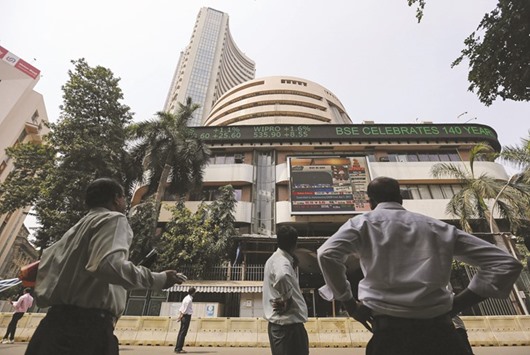Indian stocks fell in a volatile session, with the benchmark gauge capping its biggest monthly loss in four years, after the tax proposals in Finance Minister Arun Jaitley’s budget disappointed investors.
Oil & Natural Gas Corp slumped 10% and Oil India slid to a record low after the government proposed a 20% tax on locally produced crude. Maruti Suzuki India and Titan Co retreated after the budget proposed duties on cars and jewellery. Bharat Heavy Electricals, the largest power-equipment maker, dropped to its lowest price in more than a decade.
The Sensex lost 0.6% to 23,002 at the close in Mumbai, after changing direction at least 15 times. The levies were on top of the proposal for higher dividend distribution tax on those earning more and a plan to boost the securities transaction tax on equity options trading - steps that diluted the cheer stemming from the government’s pledge to further shrink its fiscal deficit that stoked speculation of an interest-rate cut by the central bank.
“The budget, for all its good points, has two weaknesses from an investor’s standpoint - it doesn’t give a fillip to the industry and consumer demand,” Ajay Srivastava, managing director at Dimensions Consulting, said by phone from New Delhi. “The economy and demand will struggle because the government is taking more money out of your kitty.” Srivastava said he has advised clients to exit from all sectors other than healthcare.
The Sensex tumbled 7.5% in February, capping the worst month since November 2011, as global funds pulled $2.5bn from domestic shares since January 1 amid a selloff in emerging markets. Central bank Governor Raghuram Rajan last month warned of higher bond yields if Prime Minister Narendra Modi strayed from the deficit-reduction path, calling macroeconomic stability India’s “single most important strength” in a time of global market turmoil.
The government stuck to its target of bringing the deficit to 3.5% of the gross domestic product in the year that starts April 1. The gap will be 3.9% of GDP in the current fiscal year, as projected, Jaitley told lawmakers yesterday. The move may help Modi win another rate cut as low global oil prices are forecast to keep inflation near next year’s target.
“There’s expectation that the RBI may cut interest rates,” Sampath Reddy, the chief investment officer at Bajaj Allianz Life Insurance Co, which has $6.5bn in assets, said by phone. “The fiscal deficit is one of the most important things and it’s good that the government has stuck to the target.” Reddy said he’s bullish on infrastructure stocks.
Oil & Natural Gas plunged 10.2%, the most since August 24. Oil India lost 3% to its lowest level since its September 2009 listing. Cairn India fell 4.7%. The S&P BSE India Oil & Gas Index slid 1.5%. The government proposes to levy 20% tax on local crude. Producers current pay a fixed duty of Rs4,500 a tonne.
“The budget gives a relief to the upstream companies in terms of change in levy of cess from specific rate to an ad valorem rate of 20%,” said K Ravichandran, co-head, corporate sector ratings, ICRA. Still, “in the event of sharp rise in oil prices beyond $45 a barrel, it will negatively impact the industry’s profits.”
Maruti Suzuki lost 5.1% to its lowest level since October 2014. Larsen & Toubro, the largest engineering company, slid 3.1%, taking this year’s loss to 16%. Hindustan Unilever fell 2.3.%, ending two days of advance. Titan plunged 4% to its lowest level since August 4.
The Sensex is valued at 14.3 times its estimated 12-month earnings, versus a multiple of 10.8 for the MSCI Emerging Markets Index. Foreigners sold a net $85mn of Indian stocks on Friday, taking this month’s outflow to $920mn. They bought $3.3bn of shares last year, the smallest in four years.
Meanwhile the rupee reversed early declines, rising 0.3% to 68.42 per dollar in Mumbai, according to prices from local banks compiled by Bloomberg. Edelweiss Financial Services is predicting more gains for the currency, which has weakened 3.3% this year in Asia’s worst performance after the South Korean won.
“We’ve seen a very positive sentiment emerging from the budget numbers,” said Ankur Jhaveri, co-head of currencies and rates at Edelweiss in Mumbai. “In the recent past, we have seen the rupee reacting to global headwinds but all said and done, we now see an appreciating trend towards 68-68.20 a dollar levels.”
The budget slotted in the missing pieces for a rally in Indian bonds and the rupee.
The benchmark 10-year yield slid 16 basis points, the most in nine months, after Modi’s government stuck to its fiscal deficit targets. The yield - which had risen five basis points in one year through Friday despite interest-rate cuts, plunging oil prices and the opening up of the debt market - will drop 13 basis points more to 7.50% by end-June, according to the median estimate of 10 fixed-income fund managers and traders in a Bloomberg survey. The rupee rallied the most since February 4.
“Fiscal consolidation was the needed link,” said Vivek Rajpal, an interest-rate strategist at Nomura Holdings Inc in Singapore. “A lower deficit means lower net supply of debt. It also enhances the chances of further rate cuts, which is another positive for the market.”
The government stuck to its target of bringing the shortfall to 3.5% of the gross domestic product in the year that starts April 1. The gap will be 3.9% of GDP in the current fiscal year, as projected, Finance Minister Arun Jaitley told lawmakers yesterday.
“Different schools of thought have argued either in favour of fiscal consolidation and stability or for less aggressive consolidation and for boosting growth,” Jaitley said in his budget speech. “I have made the policy option and decided that prudence lies in adhering to fiscal targets.”

People look at a screen displaying India’s Finance Minister Arun Jaitley presenting the budget, on a facade of the Bombay Stock Exchange building in Mumbai. The Sensex closed down 0.6% to 23,002 points yesterday, after changing direction at least 15 times.


